Subphylum Crustacea - the crustaceans
(crabs, shrimp, etc)
Defining features of the crustaceans:
Underside of a crab, showing mandibles:
Crustacean lifestyles and habitats:
In other words, this phylum does it all!
A bit of crustacean anatomy
Diagram of major organ systems:
Circulatory and respiratory systems:
Heart (including small holes called ostia through which "blood" enters heart):
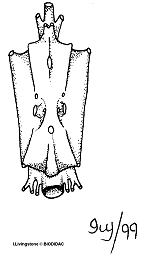
Cross-section of body (e.g. of a crayfish) showing circulatory system (red), digestive system (orange), and gills (lavendar-purple):
Note: water is moved through gill chamber by modified appendages on each side of head called gill bailers. Water is drawn through openings near lower rear of animal (just in front of tail) on each side of the body, and it exits gill chamber through openings on each side of the lower portion of the head, on either side of the mouth.
Dissected crab (that had been preserved in formaldehyde, with pink latex injected into circulatory system), showing heart (pink thing in center), gills (sort of pink things on left and right), gastric mill (the object below the heart in this photo). Note: the head region of crab is facing bottom of picture.
A sampling of some of the major crustacean groups:
Class Branchiopoda - water fleas, brine shrimp, fairy shrimp, etc.
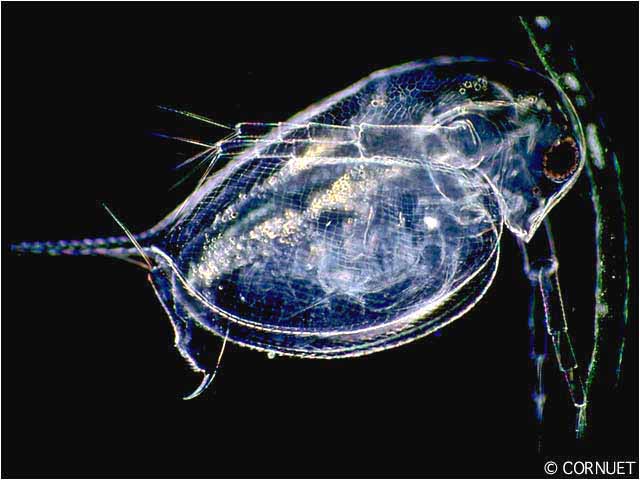
Nice photos of Cladocerans can be found at:
Cladocera web site: http:default.html
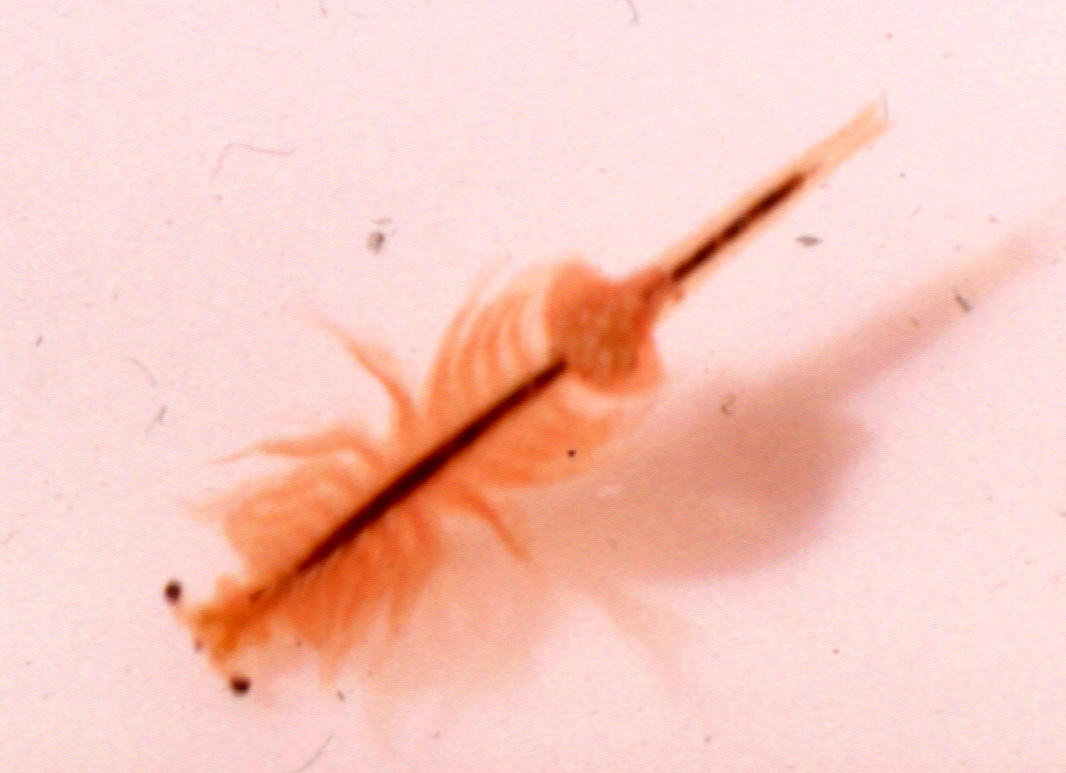
Class Ostracoda - the ostracods, or seed shrimp
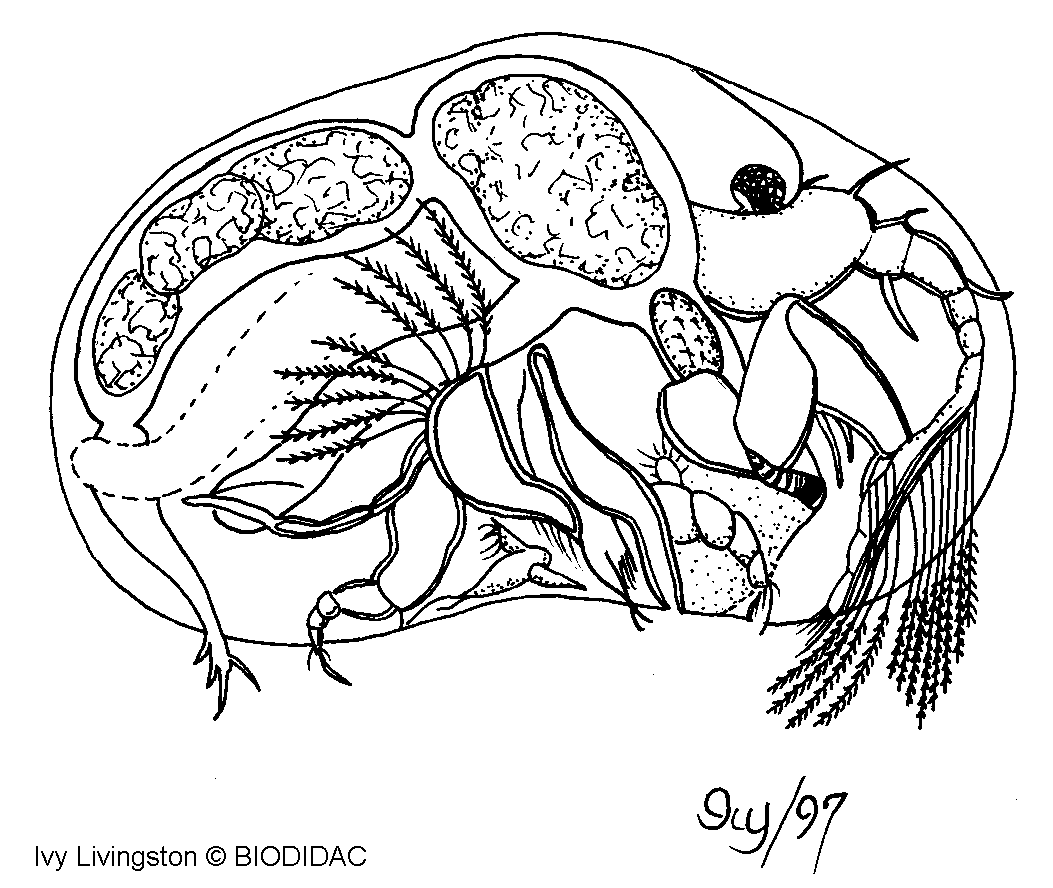
If you are really inspired about ostracods, here is an Australian site with more info: Ostracods: http:ostbiol.html
Class Copepoda - the copepods
Copepod showing water flow patterns that aid in food capture:
Copepod with paired egg sacs:
Photos of some freshwater copepods can be found here: Freshwater copepod photos: http:zoop-copep.htm
Class Cirripedia - the barnacles
"A shrimp that stands on its head and kicks food into its mouth with its feet"
Class Malacostraca - crabs, lobsters, shrimp, and others
Here are a few of the major orders:
Order Decapoda - the decapods
Decapod means "ten legged" (though often first pair are claws, not walking legs) at least 8500 described species (1/3 of the known crustaceans) marine, freshwater, land very diverse lifestyles and diets (just about everything you can imagine) this is the most familiar group of crustaceans, including most of the larger crustaceans, including: Shrimp - adapted for swimming: Nice shrimp photos Crabs - adapted for walking: Nice crab photos tail is reduced and curled under body Lobsters and crayfish - intermediate: a few photos others Order Amphipoda - the Amphiods
more than 5500 species mostly small in size marine, freshwater, a few on land (on beaches) herbivores and scavengers mostly, some predators and parasites COMMON animals typically laterally compressed A typical amphipod: 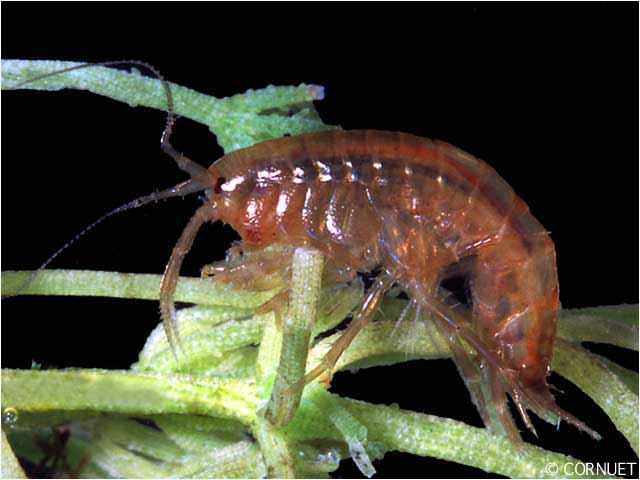
Freshwater amphipods like the one pictured above are quite small (average length usually about 1/2 inch or smaller, depending on species) but can be exceedingly abundant (dozens per square meter....or even hundreds per square meter sometimes!), and are important food for many animals (fish, birds, etc). In Minnesota, amphipods living in marshes and other wetlands are particularly important for migrating Lesser and Greater Scaups - ducks with blue bills that are commonly refered to as "bluebills" Bluebill populations are declining, and shrinking amphipod populations seem to be the cause. An article on bluebills and their dependence on amphipods can be found here ---> http://www.dnr.state.mn.us/volunteer/sepoct07/bluebills.html A slide show showing these birds can be found here:http://www.dnr.state.mn.us/volunteer/sepoct07/bluebills_slideshow.html
Order Isopoda - the Isopods
more than 4000 species mostly marine, but some very commons ones in freshwater and on land the terrestrial isopods (pillbugs and sowbugs) are the only fully terrestrial crustaceans in most areas. For more info see: Terrestrial isopods: http:isoinfo.htm mostly scavengers, omnivores, but some predators and parasites dorsoventrally flattened (a major thing that distinguishes them from the amphipods) Diagrams of typical isopods (top and bottom):
Photos and info re: nasty fish predators/parasites that are isopods: Parasitic isopod on fish: http:page.cgi?list=Damsels&filename=A7056.jpg Article on isopods by Ron Shimek....parasitic/carnivorous isopods are discussed at end of article: http://reefkeeping.com/issues/2002-05/rs/index.htm Also see photos of giant deep sea isopods: http://www.abc.net.au/science/news/stories/s812802.htm
http://www.whozoo.org/Anlife2001/chelsy/clh_Bathynomus.htmAre there other orders in this class?
YES...lots of others too many to go into here!
A few final crustacean tidbits
(sorry, no shrimp sauce to go with these tasty morsels of knowledge!)
A few amazing crustaceans:
Japansese spider crab:
See also: http://www.glf.dfo-mpo.gc.ca/sci-sci/crab-crab/images/ph_bigcrab-e.jpg
Mantis shrimp (stomotopods)- truly one of the pinnacles of arthropod evolution! What are stomatopods? What's Special about Stomatopods? Stomatopods in Multimedia - some really cool film clips
Click here for Uniramia page-Centipedes, millipedes, and insects